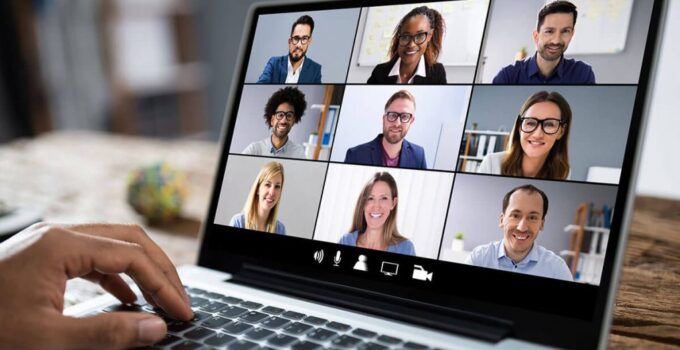Like professionals from industries of all types, lawyers have found that holding a video conference is a cost-effective alternative to travel. If your firm is involved in hosting a video conference, its success hinges on proper planning. Don’t leave your video conference’s success to chance – plan for it!
Book a Professional Videoconferencing Agency

Source: reviews.org
According to CoolpoLens, whether you host your video conferencing camera at your law firm or book a session at a nearby facility, make sure that you have a team of skilled videoconferencing professionals supporting you. Many litigation support firms will set up your conference room with professional, high-definition video equipment. This allows your attorneys to step across the threshold and create telepresence virtually anywhere in the world. Leave the technical details to the pros to ensure a trouble-free conference and allow your litigators to focus on their presentation.
Schedule the Conference with Time Differences in Mind
While you may be in Texas, the other participants may be half a world away. This makes scheduling tricky. Ideally, you’ll be able to schedule a time that falls within normal business hours for all parties involved but that’s not always possible. If the distances are such that some participants must attend at odd hours, use a world time zone map and your common sense to determine the best compromise possible. If you are hosting important clients, you’ll want to cater to your client’s scheduling preferences. While it may be inconvenient for your attorneys to come in after hours, it could be the smartest choice from a customer service perspective. To learn more about virtual meetings visit suasive.
Create and Follow an Agenda

Source: cmitsolutions.com
Just as you’d never hold a meeting without an agenda, you should never “wing it” during a video conference. Plot out your agenda in advance and share it with all participants. This ensures that all participants are aware of the topics and time allotments; it also allows them to formulate questions or provide input. If you need another attorney to present information during the conference, make sure that the attorney is aware of what you need in advance so that he can arrive prepared.
Arrive Early for Technical Testing
Arrive early enough for technical testing. The equipment will be set up and monitored by the technician, so you do not need to speak loudly or lean forward into a microphone. The technician will give you simple instructions, such as showing you where the camera is located so you can “make eye contact,” and run a couple of sound and video checks before the video conference goes live.
Stick to Your Schedule

Source: losandes.com.ar
As with traditional meetings, sticking to the schedule shows respect for other people’s time. If you’ve allotted one hour for the video conference, then the meeting should last no longer than one hour. Refer to your agenda throughout the conference and enforce all time restrictions you’ve put in place.
Companies and research units may choose to conduct important business meetings and training modules through videoconferencing.
First, you need to decide the date and time considering the places of time and holidays.
- Send a notification to all concerned about the video conference and confirm your attendance.
- When choosing a location consider audio and video quality.
- Choose the right seating arrangement by considering features such as the echo of the sound. Light furniture and a well-lit room with fluorescent lighting are recommended. Focus the room on the outside sounds as much as possible.
- Check that you have the correct network connection.
- Set up equipment such as a 27 ′ ′ 60 ′ ′ second plasma monitor, VCR or DVD player, document camera, support camera, laptops, wireless or wireless touch control panels, and more. If in doubt, seek professional help. 6. Typical video conference tips are:
Send a short note to all the speakers/presentation slides at the video conference. Position the camera in such a way that all participants are visible. Everyone needs to speak normally just as they see each other face to face. Avoid shoving feet or sheets. The microphone will capture all sounds even whisper. Apply the general rules of the meeting.
Today e-meeting or videoconferences are commonplace and participants can be anywhere in the world but attend a meeting. Participants will simply be housed in their offices instead of in the conference room. Video conferencing has become a masterpiece of audio and video technology and this process saves a lot of business time and money.
Alexander Ehrenzweig is a retired video conference agent and author of Video Conference Solutions [http://www.1866videoconference.com], a leading website for free video conference search, video conference equipment, video conference solution, video conference online, web video conference, video rental conference, video conference system, free video conference and much more.

Source: securityintelligence.com
Video conferencing is a groupware technology that allows people in two or more locations to interact simultaneously with video integration, voice calling, file sharing, instant messaging, and interactive internet browsing for both Windows and Mac applications. Thanks to the rapid development of web communications, video conferences are now widely available at a low cost. It is now used in telemedicine – used to help diagnose patients remotely, remotely consult, and transmit medical pictures and other stressful information all in real-time.
Home-based patients can easily reach out to nurses and doctors, especially during medical emergencies. Video conferences have also reduced the cost of education, as students gain access to classrooms that their schools can afford to offer in their immediate area at a lower cost.
In some cases, video conferences can replace field trips – economically disadvantaged students who are unable to visit the zoo, museums or international trips can be immersed in similar technological experiences.







